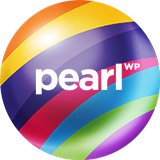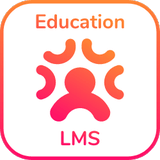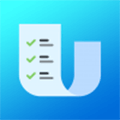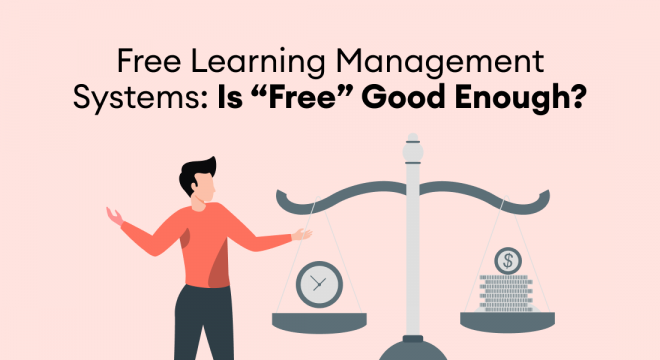There’s a common paradox in the world of business software: the word “free” is attractive because it lowers barriers to entry, but at the same time, it can limit growth. For startups and small teams, free tools are a lifeline. But as soon as the business scales, those free solutions can quickly become bottlenecks.
Does the same logic apply to Learning Management Systems (LMS)? To understand that, let’s first define what LMS actually is. Initially LMS was a platform that helped organizations create, deliver, manage, and track educational or training programs. It was a storage for courses, lessons, quizzes, and basically everything that learners could refer to access content, complete activities, and track their progress. With time passing LMS evolved, today these platforms are essential business tools. Remote work, digital transformation, and knowledge-based industries have made LMS central to how companies onboard, train, and even generate revenue through online learning.
So, is a free LMS really good enough? In this article, we’ll explore how free LMS platforms work, what they offer, where they fall short, and when it makes sense to step up to a paid solution.
What Is an LMS and Why Do Businesses Need It?
The definition of the LMS abbreviation explains itself comprehensively. A Learning Management System (LMS) is a software that helps you create, deliver, and track your training programs. Instead of piecing together email attachments, spreadsheets, and Zoom links, everything lives in one platform: lessons, quizzes, progress tracking, and reporting. In a nutshell, an LMS organizes learning like a digital classroom or training hub.
Let’s take an example: Imagine a small marketing agency. Instead of having senior staff repeat onboarding presentations to every new hire, they upload structured training courses into an LMS. New employees can go through the lessons, take quizzes, and track their own progress — while managers focus on their core work. It takes a load off the shoulders of staff members, who are responsible for the onboarding. Moreover there are different types of LMS, that could be adjusted to your pace and way of work. Both types are helpful, but have their pros and cons.
- Self-hosted LMS: Installed on your website or server, giving you full control. Popular examples: Moodle, MasterStudy LMS. Pros: customization, ownership. Cons: requires hosting, updates, and technical know-how.
- SaaS (cloud-based) LMS: Hosted externally, subscription-based, and easy to scale. Examples: TalentLMS, Docebo, LearnUpon. Pros: simplicity, managed infrastructure. Cons: ongoing monthly costs, less customization.
Being different, these two types of LMS still have something in common. Both models can be found in free or paid versions.
How Free LMS Platforms Work
Free LMS platforms generally provide the basics you need to get started:
- Course creation tools (lessons, modules, media uploads)
- Basic quizzes and tests
- Limited student or user management
The biggest appeal of free LMS software is obvious: zero financial risk. They let you experiment, test an idea, or run a pilot training program without upfront investment. Imagine a startup that wants to launch its first online workshop for clients. Instead of spending hundreds on software, they test their course with a free LMS. This allows them to validate demand before investing in scaling.
Free tools win when your goals are limited — but they rarely cover long-term, business-level requirements and plans. Does ‘free’ still sound that easy and appealing?
The Hidden Costs of “Free”
While “free” sounds costless, in practice, it can come with expenses that are less visible but more painful over time:
- Limited scalability: Many free versions cap the number of learners, courses, or storage.
- Support gaps: If something breaks, you may be left combing through community forums instead of receiving timely, professional support.
- Missing integrations: Free plans rarely connect with CRMs, HR systems, or payment gateways, making automation impossible.
- Security & compliance concerns: Free tools may not guarantee GDPR compliance, robust data protection, or enterprise-grade uptime.
- Opportunity costs: A business might save $1,000 on licensing, but lose $10,000 in wasted employee hours from manual processes.
In other words, “free” often shifts costs from software budgets to time, productivity, and opportunity. What can be done to make you benefit the most? In that case, one may find a paid LMS more beneficial than a free one. Let’s find out the real difference between these two in use.
Let’s use MasterStudy LMS as a case study.
What does the Free Version offer?
- Course builder with lessons and quizzes
- Student management basics
- Simple progress tracking
The Paid Version offers:
- Advanced quizzes, certificates, assignments
- Monetization tools (subscriptions, WooCommerce, payment gateways)
- Integrations with Zoom, Google Classroom, and CRMs
- Analytics and reporting features
- Dedicated customer support and regular updates
Comparison Table
|
Feature |
Free Version |
Paid Version |
|
Users |
Often capped |
Unlimited |
|
Content Management |
Basic courses |
Multimedia-rich, interactive |
|
Business Tools |
Minimal |
Payments, subscriptions, automation |
|
Support |
Community forums |
Professional, dedicated support |
|
Analytics |
Limited |
Full learner tracking & reporting |
Free is great for the starters. But you cannot be on the list of beginners forever. To take your progress headway, you have to increase the amount of opportunities that the platform gives you. It might require an investment, but it will definitely take you further.
The Power of Integrations
Team work produces more vast results than individual work. For modern businesses, an LMS rarely stands alone. Its true strength comes from integrations:
- LMS + Zoom = Live, interactive sessions
- LMS + Stripe/PayPal = Seamless course sales
- LMS + CRM = Track customer journeys, nurture leads, and improve retention
Unfortunately, integrations are often missing in free plans, limiting the LMS to a basic teaching tool rather than a business growth engine.
Data, Metrics, and Real Business Impact
Why do businesses outgrow free LMSs? The numbers speak for themselves:
- The global LMS market is projected to surpass $40 billion by 2029.
- Companies with strong LMS programs onboard employees 60% faster.
- Gamification and analytics can boost completion rates by 30% or more.
- Organizations with advanced training programs report 24% higher profit margins (ATD).
Let’s illustrate with examples:
- A small company stuck on a free LMS struggled: learners dropped out, no certificates were issued, and training lacked accountability.
- Another company upgraded to a paid LMS with certificates, analytics, and integrations. They reported higher engagement, measurable ROI, and smoother operations.
Even nonprofits can benefit: open-source tools qlike Moodle and Google for Nonprofits offer free or discounted LMS access, proving that value doesn’t always have to come with a heavy price tag.
When Is “Free” Good Enough?
Free LMS is ideal when:
- Testing ideas or launching a pilot project
- Managing a small team with simple training needs
- Running low-stakes, non-critical courses
Paid LMS becomes necessary when:
- Scaling beyond 100+ learners
- Monetizing courses or offering certifications
- Meeting compliance and reporting requirements
- Building a polished, professional learning brand
Depending on your plans, whether they are short-term or long-term, both types of LMS, free and paid, can benefit your business. The question is how do you align your LMS choice with your business goals.
The truth is, choosing the right LMS isn’t just a software decision — it’s a strategic business move.
- Growth → You’ll need scalability and automation.
- Customer loyalty → Certificates, gamification, and engagement tools matter.
- Revenue generation → Payments, subscriptions, and marketing integrations are non-negotiable.
Questions that might be helpful for you to decide which LMS type you need:
- Does your LMS reduce onboarding and training time?
- Can it grow as your business scales?
- Does it help you generate revenue from learning?
- Does it provide measurable ROI through analytics?
If the answer to these is “no,” free probably isn’t enough.
To sum up, Is “Free” Good Enough?
Free LMS platforms are fantastic launchpads. They let businesses experiment, save money in the early stages, and validate learning ideas. But they are rarely enough for serious, scalable, and business-critical operations.
If your goals include growth, monetization, compliance, or long-term ROI, then investing in a premium LMS is less of a cost and more of an opportunity.
Free gets you started. Paid gets you where you want to go.

































